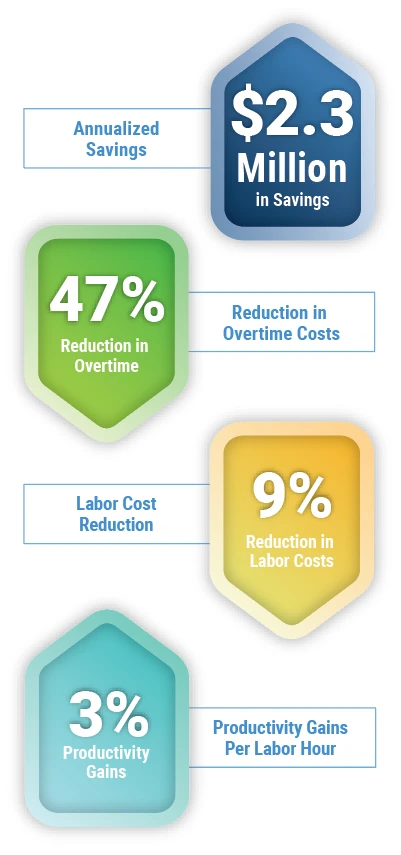

Project Overview
Introduction
For large-scale distribution companies, optimizing workflows, managing costs, and improving employee engagement are critical to sustaining growth and maintaining a competitive edge. One such national leader in medical supply chain logistics and distribution faced significant operational challenges despite being an industry front-runner. To address these issues, the company engaged POWERS for a transformative project to reshape management and operational oversight.
This case study highlights how POWERS helped a large-scale distribution company overhaul its management systems and significantly improve operational efficiency. This resulted in measurable cost savings, productivity enhancements, and cultural shifts toward accountability.
Background
The company, which began as a small warehouse operation, experienced rapid growth over several decades, evolving into a major player in the logistics and distribution sector. With tens of thousands of employees and a vast network of warehouse space spread across the country, the company was able to offer next-day shipping to nearly all of its customers in the United States. The ability to scale quickly allowed the company to dominate its market, but this rapid expansion also created new challenges.
As the company grew, its operational structure became increasingly complex. Leadership recognized that while the business had scaled impressively in size and output, its internal processes, management systems, and supervisory oversight had not kept pace. Inefficiencies began to emerge, particularly at one of the company’s key distribution centers, where goals around quality, service, cost, and people management were consistently falling short.

Performance Results

Read the Full Case Study Here
Situation
The distribution center was one of the company’s largest and most critical hubs for meeting customer demand. Despite the branch’s reputation as a top safety performer, it failed to meet several key operational targets. Leadership identified several deep-seated issues that were contributing to these failures:
- Over-reliance on Reports: The company had developed a culture where problems were addressed by generating reports. Over time, these reports accumulated across multiple systems, but no one clearly understood where the data came from or how to interpret it. As a result, employees frequently dismissed the reports, saying, “I don’t trust this information” or “This doesn’t measure what’s important.”
- Lack of Supervisor Structure: The branch’s supervisors did not operate with a set structure. Without daily or weekly routines, each supervisor managed their team differently, resulting in inconsistent practices. There were no regular performance reviews, and supervisors had little guidance on managing shifts or addressing issues as they arose.
- Poor Overtime Management: Overtime hours were not actively monitored, leading to inflated labor costs. Employees were free to come and go as they pleased, with no clear start or end times for their shifts.
- Administrative Burdens: Frontline supervisors spent 54% of their time on administrative tasks, leaving just 15% to focus on actively supervising, coaching, and engaging with their teams. This limited time for direct oversight contributed to a lack of accountability and poor productivity.
Analysis
A deep diagnostic assessment was conducted, revealing several critical weaknesses in the operational structure:
- Supervisory Weaknesses: Supervisors scored poorly in 10 out of 12 categories on a skills assessment, particularly in employee training, involvement, and work assignments. Many supervisors lacked the skills to engage effectively with their teams, leading to vague instructions and minimal accountability.
- Equipment Shortages: A lack of available equipment further impacted productivity. During the first 1-2 hours of each shift, employees often wandered around the warehouse looking for power tools and RF scanners, which were in short supply. This wasted time significantly hampered shift productivity.
- Delayed Performance Data: Supervisors could not track real-time hourly performance data. Instead, performance metrics were delayed by 24-48 hours, making it impossible to address issues as they occurred.
- Ineffective Meetings: Team meetings were consistently rated as ineffective, with the highest score being 45%. Meetings lacked clear agendas, and participants often left without actionable follow-ups.
Plan
POWERS designed and implemented a 26-week operational improvement plan, focusing on key areas that would lay the foundation for long-term success. The plan aimed to provide:
- Standardized Communication: POWERS introduced structured communication points through daily startup meetings, weekly performance reviews, and standardized agendas. This ensured all employees were aligned with the day’s objectives and aware of the company’s broader goals.
- Real-Time KPIs: Real-time performance KPIs were introduced to allow supervisors to track and address productivity issues as they arose. This was complemented by consolidating essential KPIs into weekly reports, providing a snapshot of performance trends in safety, quality, delivery, cost, and people.
- Accountability Meetings: Weekly accountability meetings were established, requiring supervisors to present the previous week’s performance data along with corrective actions taken to address underperformance.
- Supervisor Engagement: A systematic approach was developed to encourage more active supervisor engagement. Supervisors were trained to give regular feedback to high and low performers and engage with their teams throughout the shift, not just during administrative moments.
- Overtime Control and Scheduling Alignment: The company implemented new overtime controls, requiring pre-authorization for additional hours and aligning employee schedules for more efficient operations. This process ensured that all employees started and ended their shifts at consistent times.
Implementation
The project’s implementation phase was designed to be thorough, ensuring that every element of the plan was integrated into the daily operations of the distribution center. Some key steps included:
- Establishing a consistent meeting cadence and ensuring every meeting followed a clear agenda with pre-determined goals and follow-ups.
- Realigning the roles of supervisors to ensure they spent less time on administrative tasks and more time supervising, coaching, and supporting their teams.
- Implement core workshops for supervisors to refine skills in key areas such as leadership, time management, and employee engagement.
- Deploying new performance tracking tools that allowed supervisors to access real-time data on employee productivity, empowering them to make decisions based on accurate, up-to-date information.
Results
The results of the engagement were nothing short of transformative:
- Overtime Reduction: Within 13 weeks, the branch reduced overtime hours by 47%, largely due to the new pre-authorization process and better shift scheduling.
- Labor Cost Reduction: By actively managing hourly performance and overtime, labor costs as a percentage of sales were reduced by 9%.
- Productivity Gains: Lines per paid labor hour improved by 3%, directly resulting from increased supervisor engagement and improved shift productivity.
- Financial Impact: By the end of the project, the company realized $2.4 million in annualized savings, attributed to enhanced operational efficiencies and better labor cost management.




